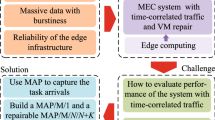Abstract
In order to relieve the pressure of the local devices, some tasks need to be offloaded to the edge computing system. In order to guarantee the service level of the edge computing system, virtual machines (VMs) deployed in the edge server should be as active as possible. For light load application scenarios such as smart home, to meet the quality of service of tasks while coping with occasional VM failures, we propose a task offloading strategy with real-time VM repair in an edge computing system. Accordingly, we establish a repairable queueing model with multiple servers and VM-dependent failure rates. By using quasi-birth-death process and matrix-geometric solution method, we give the average latency of tasks in steady state. Considering that the number of tasks and the VM state are fully unobservable, we construct profit functions to study the Nash equilibrium arrival rate of tasks and the socially optimal arrival rate of tasks. In order to maximize the social profit, we present a pricing policy for tasks in the edge computing system with the proposed strategy.







Similar content being viewed by others
Data availability
The datasets generated and analysed during the current study are available from the corresponding author on reasonable request.
References
Ma, Q., Huang, H., Zhang, W., Qiu, M.: Design of smart home system based on collaborative edge computing and cloud computing. In: Algorithms and Architectures for Parallel Processing, pp. 355–366 (2020). https://doi.org/10.1007/978-3-030-60248-2_24
Duan, Q., Wang, S., Ansari, N.: Convergence of networking and cloud/edge computing: status, challenges, and opportunities. IEEE Network 34(6), 148–155 (2020). https://doi.org/10.1109/MNET.011.2000089
Babou, C., Fall, D., Kashihara, S., Niang, I., Kadobayashi, Y.: Home edge computing (HEC): design of a new edge computing technology for achieving ultra-low latency. In: International Conference on Edge Computing, pp. 3–17 (2018). https://doi.org/10.1007/978-3-319-94340-4_1
Li, W., Jin, S.: Performance evaluation and optimization of a task offloading strategy on the mobile edge computing with edge heterogeneity. J. Supercomput. (2021). https://doi.org/10.1007/s11227-021-03781-w
Zaman, S., Jehangiri, A., Maqsood, T., Ahmad, Z., Umar, A., Shuja, J., Alanazi, E., Alasmary, W.: Mobility-aware computational offloading in mobile edge networks: a survey. Clust. Comput. 24(4), 2735–2756 (2021). https://doi.org/10.1007/s10586-021-03268-6
Li, S.: A task offloading optimization strategy in MEC-based smart cities. Internet Technol. Lett. 4(1), e158.1–e158.5 (2020). https://doi.org/10.1002/itl2.158
Yand, P., Li, L., Liang, W., Zhang, H., Ding, Z.: Latency optimization for multi-user NOMA-MEC offloading using reinforcement learning. In: 28th Wireless and Optical Communications Conference (WOCC), pp. 1–5 (2019). https://doi.org/10.1109/WOCC.2019.8770605
Jin, S., Yue, W.: Resource Management and Performance Analysis of Wireless Communication Networks. Springer, Singapore (2021)
Lv, S., Zhu, L.: Single server repairable queueing system with variable service rate and failure rate. IEEE Access 9, 1233–1239 (2021). https://doi.org/10.1109/ACCESS.2020.3047815
Kuki, A., Bérczes, T., Sztrik, J., Kvach, A.: Numerical analysis of retrial queueing systems with conflict of customers and an unreliable server. J. Math. Sci. 237(5), 673–683 (2019). https://doi.org/10.1007/s10958-019-04193-1
Ammar, S.I., Rajadurai, P.: Performance analysis of preemptive priority retrial queueing system with disaster under working breakdown services. Symmetry 11(3), 419 (2019). https://doi.org/10.3390/sym11030419
Klimenok, V., Dudin, A., Shumchenia, U.: A multi-server queueing system with backup servers. In: Information Technologies and Mathematical Modelling (ITMM), pp. 117–128 (2018). https://doi.org/10.1007/978-3-319-97595-5_10
Peschansky, A.I.: Stationary characteristics of an unreliable multi-server queueing system with losses and time redundancy. Autom. Remote. Control. 80(4), 648–665 (2019). https://doi.org/10.1134/S0005117919040040
Zhang, C., Du, H.: DMORA: decentralized multi-SP online resource allocation scheme for mobile edge computing. IEEE Trans. Cloud Comput. (2020). https://doi.org/10.1109/TCC.2020.3044852
Abdah, H., Barraca, J.P., Aguiar, R.L.: Exploiting virtual machine commonality for improved resource allocation in edge networks. J. Sens. Actuator Netw. 9(4), 58 (2020). https://doi.org/10.3390/jsan9040058
Liu, Y., Zhang, A., Xia, X., Chen, F., Ye, L., Zhang, B., He, Q.: Proactive data caching and replacement in the edge computing environment. In: IEEE 13th International Conference on Cloud Computing (CLOUD), pp. 193–200 (2020). https://doi.org/10.1109/CLOUD49709.2020.00038
Fan, Q., Lin, J., Feng, G., Gao, Z., Wang, H., Li, Y.: Joint service caching and computation offloading to maximize system profits in mobile edge-cloud computing. In: 16th International Conference on Mobility, Sensing and Networking (MSN), pp. 244–251 (2020). https://doi.org/10.1109/MSN50589.2020.00050
Kadir, N.: Observation of the common phenomena from a MATLAB model for M/M/1 queuing system. In: International Conference on Advances in Electrical Engineering (ICAEE), pp. 210–212 (2015). https://doi.org/10.1109/ICAEE.2015.7506833
Neuts, M.: Matrix-Geometric Solutions in Stochastic Models. Johns Hopkins University Press, Baltimore (1981)
He, Q., Neuts, M.: On the convergence and limits of certain matrix sequences arising in Quasi-Birth-and-Death Markov chains. J. Appl. Probab. 38(2), 519–541 (2001). https://doi.org/10.1239/jap/996986760
Liu, Q., Chen, G.: A note on the preconditioned Gauss–Seidel method for M-matrices. J. Comput. Appl. Math. 219(1), 59–71 (2008). https://doi.org/10.1016/j.cam.2008.07.056
Funding
This work was supported by National Natural Science Foundation (Grant Numbers 61872311, 61973261, 62006069), China.
Author information
Authors and Affiliations
Corresponding author
Ethics declarations
Conflict of interest
The authors have no conflicts of interest to declare that are relevant to the content of this article.
Code availability
The code generated during the current study are available from the corresponding author on reasonable request.
Additional information
Publisher's Note
Springer Nature remains neutral with regard to jurisdictional claims in published maps and institutional affiliations.
Rights and permissions
About this article
Cite this article
Guo, X., Du, Z. & Jin, S. Nash equilibrium and social optimization of a task offloading strategy with real-time virtual machine repair in an edge computing system. Cluster Comput 25, 3785–3797 (2022). https://doi.org/10.1007/s10586-022-03603-5
Received:
Revised:
Accepted:
Published:
Issue Date:
DOI: https://doi.org/10.1007/s10586-022-03603-5




